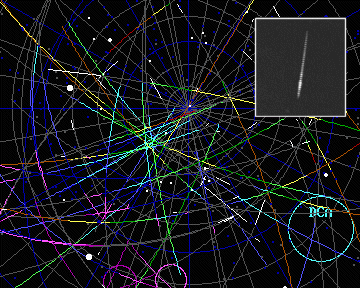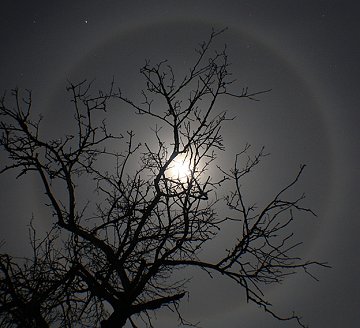SATELLITE FLYBYS APP: Turn your iPhone or iPod into a field-tested satellite tracker! Spaceweather.com presents the Satellite Flybys app. | | | SPIRIT NOW A STATIONARY SCIENCE PLATFORM: NASA announced today that Mars rover Spirit cannot be freed from its Martian sandtrap. Now Spirit will begin a second career as a stationary science platform. Get the full story from Science@NASA. MINOR METEOR OUTBURST: On the night of Jan. 20/21, an unexpected flurry of ten meteors emerged from the vicinity of Ursa Minor, the Little Dipper. "They were recorded by a network of six video cameras operated by amateur astronomers in Finland," report Peter Jenniskens of the SETI Institute in California and Esko Lyytinen of Helsinki, Finland. "We call them 'gamma Ursae Minorids.'" This image shows a sky map of meteor trails recorded by the video network that night: 
Image courtesy Esko Lyytinen and Peter Jenniskens
The gamma Ursae Minorids are traced in blue. "Note how the blue lines converge near a single radiant point," says Jenniskens. Inset is an actual meteor recorded by one of the cameras. This isn't the first time the gamma Ursae Minorids have attracted attention. Peter Brown and coworkers at the University of Ontario have recorded their echoes for the past five years using the Canadian Meteor Orbit Radar (CMOR). But until now, the meteors were invisibly faint. According to Jenniskens, 2010 marks the first bright outburst that could be seen with the unaided eye. "The source of this shower has not been identified," says Jenniskens. "It is probably a short-period comet passing not far from Jupiter. The 11-day duration of the gamma Ursae Minorids [in radar records] suggests that some significant breakup occurred not too long ago and the comet may now be hiding among the high inclination (i = 48.5 deg.) near-Earth asteroid population." Will this brightening shower make an even bigger splash next year? No one knows, but Jenniskens plans to mark his calendar for Jan. 20, 2011: Don't forget the gamma Ursae Minorids. LUNA-VERSE: Northern skies are icy. The Moon is waxing bright. Add these things together. Voila! A moon halo tonight: 
Photo details: Canon EOS 1000D, ISO400, f5.6, 30 sec exposure
All around the northern hemisphere, sky watchers are reporting luminous rings around the Moon. "I saw this one on Jan. 25th," says photographer Rafael Schmall of Kaposfo, Hungary. "It was intense!" The phenomenon is caused by ice crystals in the air and has been known to inspire episodes of poetry. The verse should improve this Friday, Jan. 29th, when the Moon brightens to full intensity. On the same night, Mars will approach the Moon for a beautiful conjunction inside the halo. Take a look.
January Northern Lights Gallery
[previous Januarys: 2009, 2008, 2007, 2005, 2004, 2001]
Solar Eclipse Photo Gallery
[World Map of Eclipse Sightings] | 
